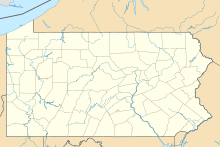Carnegie Museum of Natural History - Simple English Wikipedia, the free encyclopedia
 One of the four Carnegie Museums of Pittsburgh | |
| Established | 1896 |
|---|---|
| Location | Pittsburgh, Pennsylvania |
| Coordinates | 40°26′37″N 79°57′02″W / 40.44358°N 79.950560°W |
| Type | Natural History |
| Visitors | 300,000 |
| Director | Eric Dorfman, PhD (2015-present) |
| Public transit access | 54, 58, 61A, 61B, 61C, 61D, 67, 69 |
| Website | www |
The Carnegie Museum of Natural History (abbreviated as CMNH) is a natural history museum in the Oakland neighborhood of Pittsburgh, Pennsylvania.
Reputation
[change | change source]It has an international reputation for research and is ranked among the top five natural history museums in the United States.[1]
The museum gained prominence in 1899 when its scientists unearthed the fossils of Diplodocus.[2] Today its dinosaur collection has the world's largest collection of Jurassic dinosaurs. Its Dinosaurs in Their Time exhibition is the third largest collection of mounted, displayed dinosaurs in the United States (behind the Smithsonian's National Museum of Natural History and the American Museum of Natural History).
Notable specimens include one of the world's only fossils of a juvenile Apatosaurus, the world's first specimen of a Tyrannosaurus rex,[3] and a recently identified species of oviraptorosaur named Anzu wyliei.[4]

References
[change | change source]- ↑ "Carnegie Museum of Natural History - Press Room". Carnegiemnh.org. Archived from the original on 2012-10-18. Retrieved 2012-09-14.
- ↑ Batz Jr., Bob (1999-07-02). "Dippy the star-spangled dinosaur". Pittsburgh Post-Gazette. Pittsburgh. Archived from the original on 2011-06-29. Retrieved 2009-08-11.
- ↑ Switek, Brian (2013-10-16). "My T. Rex Is Bigger Than Yours". National Geographic. Pittsburgh. Retrieved 2014-06-16.
- ↑ Webner, Richard (2014-03-20). "Carnegie Museum unveils dinosaur nicknamed 'chicken from hell'". Pittsburgh Post-Gazette. Pittsburgh. Retrieved 2014-04-14.


 French
French Deutsch
Deutsch